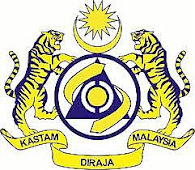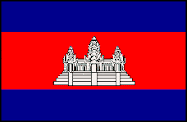Back To The Temples
Fortified with breakky and a nice hot cuppa tea, it was time to set off again. I knew I wanted to see certain temples, and Zola, my driver seemed to know just which order this should be done. Gordon, the owner of Two Dragons, had said when I was debating on whether to get a guide or not, the driver would know where to go.
And so it proved. We set out at a steady pace (I think I've already said my drivers were Speedy Gonzales!) - gone was the coolness of the early morning, although the weather was still pleasant. We arrived at the South Gate of Angkor Thom, and ahead were many people and vehicles. Zola instructed me to "You walk". Everybody walks along the long, long path.
Angkor Thom
Above: South Gate of Angkor Thom
As you walk along the pathway, dwarfed on either side by massive gods, demons and nagas, you have a sense of awe and wonder. Over one thousand years ago, before electricity, before gas, long, long before the telephone had been invented, huge temples and cities were being built by hand. The massive stones were brought from across the oceans, across the lands by men and elephants - there were no trucks, no trains, no railways.
Imgaine if you will, the scene this evokes - hundreds and hundreds of men, with their bare hands and little else, hauling these weighty stones, day after day while they carried all the bits and pieces that they used on a daily basis, as well as everything else needed for construction. Imagine cleaning up all the elephant droppings, feeding and cleaning them as well as themselves. And of course these magnificent temples weren't built overnight - nor even in a year. They took several years and thousands of hours of manpower to leave us with what we see to day. That these temples are still standing over a thousand years later is testimony to the strength, courage and ingenuity of these men from earlier times.
Above: Statues on the bridge leading to Victory Gate
One of the five gateways into the ancient Khmer city of Angkor Thom is the Victory Gate. It is the second most visited of the five Angkor Thom gates and is at the end of the Royal Road that extends from the compound of the Royal Palace of Angkor Thom, where the Terrace of the Elephants are located, past the towers of Prasat Suor Prat, as the road leads eastwards in the direction of Thommanon and Chau Say Tevoda.
History of Angkor Thom
The city of Angkor Thom was founded by Angkor's greatest king, Jayavarman VII, who reigned from 1181 to 1219 AD and who came to power following the defeat of the former Khmer capital by the Chams. At its height, Angkor Thom governed and ruled over one million souls in the surrounding area.
Angkor Thom was built in an almost perfect square, the sides of which run east to west and north to south. It was surrounded by a square wall (jayagiri) 8 metres high and 12 kilometres in length and was further protected by a 100 metre wide moat, said to have contained ferocious crocodiles.
Angkor Thom, or more correctly, Angkor Thum is Khmer for Angkor-the-Great or Great City.
In exactly the middle of each wall, a gate opened from which a bridge extended over the moat to the area outside the royal city. Angkor was the capital of the Khmer Empire of Cambodia from 802 until 1295.
Above: Face tower of the South Gate showing Avalokiteśvara
Each gate to Angkor Thom displays the four faces of the bodhisattva Avalokiteśvara.
According to Mahayana doctrine, Avalokiteśvara is the bodhisattva who made a great vow to listen to the prayers of all sentient beings in times of difficulty, and to postpone his own Buddhahood until he had assisted every being on Earth in achieving nirvana.
Above: Deva
I thought it was very interesting to see an 'albino' Deva.
Malaysia Time
Click On Your Flag To Translate
Malaysia and Cambodia
Hello,
This is about my upcoming trip to Malaysia and Cambodia. The first part is pre-trip - information about flights, itineraries, accommodation and all the things that you need to do to plan an overseas holiday. This is my first trip to Asia and I hope it may help others. Comments are very welcome and anyone who has travelled to Malaysia and/or Cambodia, please feel free to comment and offer any advice or tips that you think would be helpful. As of today ( 28th February) , in exactly 11 days (minus 30 minutes) I will be in Kuala Lumpur.
Cheers.
I had the most amazing time and hope you enjoy reading about my trip. Each post is numbered and I'm doing them in order from start to finish - a little like a diary.
ANGKOR WAT SUNRISE
This is about my upcoming trip to Malaysia and Cambodia. The first part is pre-trip - information about flights, itineraries, accommodation and all the things that you need to do to plan an overseas holiday. This is my first trip to Asia and I hope it may help others. Comments are very welcome and anyone who has travelled to Malaysia and/or Cambodia, please feel free to comment and offer any advice or tips that you think would be helpful. As of today ( 28th February) , in exactly 11 days (minus 30 minutes) I will be in Kuala Lumpur.
Cheers.
I had the most amazing time and hope you enjoy reading about my trip. Each post is numbered and I'm doing them in order from start to finish - a little like a diary.
Wednesday
Subscribe to:
Post Comments (Atom)












2 comments:
Thanks for posting the pictures! I was there about 2005. The one thing I saw lots of that you didn't show was the throngs of people, mostly young or children. The world should help the Cambodians preserve their treasures. So much is simply falling apart as the elements and plant growth does its work.
Thanks Brian, I'm happy you enjoyed the photos. There were many, many people and I tried to capture some pics without them. And yes, I do agree with helping to preserve the Cambodian treasures. The poverty I saw in Cambodia was heart wrenching - they have nothing, yet they still smile. It made me feel very humble.
Post a Comment